Introduction to American Government
Topic outline
-
Welcome to Introduction to American Government!
Course Introduction
Welcome to American Government! In this course, we will discuss how the American Governmental system is set up, operates, and functions. Additionally, you are going to become more aware of how the US government interacts with your everyday life. After taking this class, students should have a basic understanding of governmental and constitutional construction, as well as how the various branches of the US government operate. Students will also become aware of current events and the impact that trends in US politics have on reaction to these events.Course Learning Objectives
- Identify and understand the historical and political context of the
creation of the Declaration of Independence and the US Constitution.
- Analyze differences between the American form of government and other national governance structures.
- Describe the contributions and challenges of underrepresented populations within the American context.
- Describe the rights, civil liberties, and responsibilities of citizens within the American context.
- Explain the selection process of US Political Leadership, and how
citizens can be informed and engaged with the political process.
Adopting institution should provide learners information on how to navigate the course. Consider adding an introductory navigation video. Text description could include, for example:Navigating the Course
This course is set up in Modules covering various topics which may be accessed from the course navigation menu on the left or by scrolling below. Modules may be collapsed in the menu and it the body of the course to minimize scrolling. Each module includes the relevant chapters followed by various activities, which may include discussion forums, listening activities and quizzes, practice quizzes, module tests, and other relevant activities as appropriate for each module. Many items are required and may be marked as completed automatically when the activity has been submitted (the broken check box), but others will marked as done by the student (the solid check box).Please move through the items below and continue through the Learner Support and Getting Started modules before moving on to Module 1. Be sure to check for announcements and due dates to stay on track.
 This course and its contents are licensed under a Creative Commons Attribution 4.0 International License by LOUIS: The Louisiana Library Network, except where otherwise noted.
This course and its contents are licensed under a Creative Commons Attribution 4.0 International License by LOUIS: The Louisiana Library Network, except where otherwise noted. - Identify and understand the historical and political context of the
creation of the Declaration of Independence and the US Constitution.
-
Chapter 1: American Government and Civic Engagement
-
This module contains all the items you should review and complete before you begin Module 1. Before moving on, be sure to:
- Check the News and Announcements Forum
- Read the Course Syllabus
- Introduce yourself to the class
- Read the instructions for the Q & A Forum
Good luck in the course!-
Use this forum to tell us a little about yourself and your interests. Some topic ideas:
- What is your field of study/research interest or concentration?
- What are you most interested in learning about in this class and why?
- Have you ever taken an online class before?
- Any other information you would like to share with your classmates, such as special interests or activities.
Post a picture! We look forward to meeting you.
-
Use this forum to ask your instructor any questions you have about the course. You may post at any time, and your instructor will respond here. Be as specific as possible.
Please keep in mind that others can see your posts, so do not post any personal information. If you have questions about your grade, please email your instructor directly. You can expect a response to posts and emails within [X] hours. [Recommendation is 24 hours M-F, next business day on weekends.]
Subscription should be set to Auto.
- Check the News and Announcements Forum
-
Use the information in this module to customize the template to your needs. This module is currently hidden from students, and available for you to refer to throughout the semester.
-
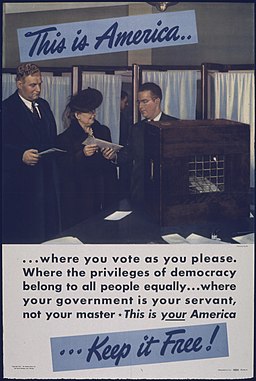
Government impacts every aspect of peoples’ lives, and knowledge of government helps us to better understand the ways in which we can influence governmental effectiveness in addressing our needs. Government can be defined as an organized entity of American society responsible for social order, public services, and security and defense in accordance with power granted by law. Knowing the principles and institutional design of the American government is crucial to the role students can play in ensuring and securing their well-being and happiness in American society.
In this Module, we examine what is government, the types of governments, and politics within the American governmental system and other governmental systems. Next, we present perspectives on the representativeness of the U.S. system of government and the role of tradeoffs. Finally, we examine citizen engagement's effectiveness in influencing government and the factors shaping people's willingness to become engaged.Image Attribution: Modification of work by the National Archives and Records Administration)Upon completion of this module, you will be able to:- Define the key concepts, characteristics, and types of government. (CLO 2)
- Explain the differences between U.S. governmental system and alternative
government systems of other nations. (CLO 2)
- Assess the pros and cons of the pluralist-elite debate and the merits of
the tradeoff perspectives of American government. (CLO 2,3)
- Explain current role of citizen engagement in influencing governmental
outcomes. (CLO 5)
To achieve these objectives:- Read Chapter 1 in Introduction to American Government. Including:
- Introduction to American Government (opens in new window)
- What is Government? (opens in new window)
- Who Governs? Elitism, Pluralism, and Tradeoffs (opens in new window)
- Engagement in a Democracy (opens in new window)
- Chapter 1 Review (opens in new window)
Note the check boxes to the right that help you track your progress: some are automatic, and some are manual.
Module Pressbooks Resources and Activities
You will find the following resources and activities in this module at the Pressbooks website. Click on the links below to access or complete each item.
- Define the key concepts, characteristics, and types of government. (CLO 2)
-

Image Attribution: Modification of work by National Archives and Records Administration)
This module will examine the core values in American political thought, and structure and dynamics of our American Government system to provide historical and current day contextual information about our American political system and how it works. Ultimately, by the end of this module each member of the class will gain a deeper, more comprehensive understanding of the forces that shape our American Government and its processes.
Upon completion of this module, you will be able to:- Identify the origins of the core values in American political thought. (CLO 1)
- Explain why the Articles of Confederation were weak. (CLO 1)
- Explain the Great Compromise. (CLO 1)
- Explain our Check and Balance system in the United States. (CLO 1)
To achieve these objectives:- Read Chapter 2 in Introduction to American Government. Including:
- Introduction to the Constitution and Its Origins (opens in new window)
- The Pre-Revolutionary Period and the Roots of the American Political Tradition (opens in new window)
- The Articles of Confederation (opens in new window)
- The Development of the Constitution (opens in new window)
- The Ratification of the Constitution (opens in new window)
- Constitutional Change (opens in new window)
- Chapter 2 Review (opens in new window)
Module Pressbooks Resources and Activities
You will find the following resources and activities in this module at the Pressbooks website. Click on the links below to access or complete each item.
- Identify the origins of the core values in American political thought. (CLO 1)
-

Image Attribution: Modification of work by Boston Public Library
This chapter will be discussing the balance between federal and state powers. Because the national government and state governments may have different policy preference, battles over the balance between federal and state power are inherent in the U.S. federalist system. Also, there will be an evolutionary look at how the federal powers expanded.
Upon completion of this module, you will be able to:- Define federalism and explain its significance. (CLO 1)
- Explain what the Constitution says about federalism. (CLO 1)
- Identify the major shifts in state and federal government power over time. (CLO 4)
- Describe the major trends and debates in federalism today. (CLO 5)
To achieve these objectives:- Read Chapter 3 in Introduction to American Government. Including:
- Introduction to American Federalism (opens in new window)
- The Division of Powers (opens in new window)
- The Evolution of American Federalism (opens in new window)
- Intergovernmental Relationships (opens in new window)
- Competitive Federalism Today (opens in new window)
- Advantages and Disadvantages of Federalism (opens in new window)
- Chapter 3 Review (opens in new window)
Module Pressbooks Resources and Activities
You will find the following resources and activities in this module at the Pressbooks website. Click on the links below to access or complete each item.
- Define federalism and explain its significance. (CLO 1)
-

This module will provide an explanation between civil rights and civil liberties and will focus on the study of civil liberties, which are protected by the Constitution of the United States. Emphasis will be placed upon the first ten amendments that form the Bill of Rights and protects the freedoms and rights of individuals. It will also explain why interpreting some amendments have been and continue to be controversial.
Image Attribution: National ArchivesUpon completion of this module, you will be able to:- Explain the difference between a civil liberty and a civil right. (CLO 4)
- Explain what civil rights protect and guarantee for U.S. citizens. (CLO 3)
- Explain why the Bill of Rights was created a part of the U.S. Constitution. (CLO 2)
- Explain what constitutional rights the civil rights laws ensured for African Americans and other minorities. (CLO 4)
To achieve these objectives:- Read Chapter 4 in Introduction to American Government. Including:
- Introduction to Civil Liberties (opens in new window)
- What are Civil Liberties? (opens in new window)
- Securing Basic Freedoms (opens in new window)
- The Rights of Suspects (opens in new window)
- Interpreting the Bill of Rights (opens in new window)
- Chapter 4 Review (opens in new window)
Module Pressbooks Resources and Activities
You will find the following resources and activities in this module at the Pressbooks website. Click on the links below to access or complete each item.
- Explain the difference between a civil liberty and a civil right. (CLO 4)
-
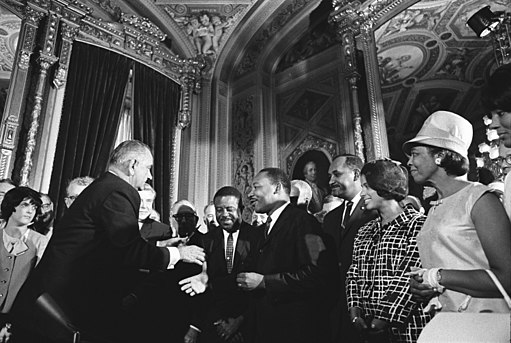
Image Attribution: Modification of “Lyndon Johnson and Martin Luther King, Jr. – Voting Rights Act” by Yoichi Okamoto/Wikimedia Commons, Public Domain
The struggles of citizens who happen to be members of "identifiable groups " for equal treatment and inclusion denied them by government and society based ascribed traits is the central concern of civil rights. Despite the flowering words of the Declaration of Independence and the U.S. Constitution about freedom and equality, this country began with many citizens being treated differently based on status, race, ethnicity, color, gender, sexual orientation, religion, and disability.
The fight for civil rights encompasses changes in laws and governmental actions such that groups of Americans excluded from certain rights and privileges can obtain the same rights and privileges as all other Americans. In this module, we will examine the struggles of African-Americans, women, Hispanics and Latinos, Asian-Americans, Native Americans, the LGBTQ community, persons with disabilities, and religious minorities to combat discrimination, unequal treatment and sometimes hate that has been an essential feature of the growth and progress of American Democracy.
Upon completion of this module, you will be able to:- Explain the differences between having civil rights in law and
in practice,known as "de jure," but not in fact, also known
as "de facto," related segregation and inequality of opportunity and
outcomes. (CLO 3, 4, 5)
- Describe the roles and contributions racial and non-racial groups
made through citizen action and activism to ensure that civil rights are
protected from the past to the present. (CLO 3, 4, 5)
- Explain the major laws and governmental actions leading to the expansion of rights and privileges for major groups. (CLO 3, 4)
- Describe the roles of the major executive, legislative, and judicial institutions in advancing and impeding the expansions of rights and privileges
of discriminated groups. (CLO 1, 3, 4)
To achieve these objectives:- Read Chapter 5 in Introduction to American Government. Including:
- Introduction to Civil Rights (opens in new window)
- What are Civil Rights and How Do We Identify Them? (opens in new window)
- The African American Struggle for Equality (opens in new window)
- The Fight for Women's Rights (opens in new window)
- Civil Rights for Indigenous Groups: Native Americans, Alaskans, and Hawaiians (opens in new window)
- Equal Protection for Other Groups (opens in new window)
- Chapter 5 Review (opens in new window)
Module Pressbooks Resources and Activities
You will find the following resources and activities in this module at the Pressbooks website. Click on the links below to access or complete each item.
- Explain the differences between having civil rights in law and
in practice,known as "de jure," but not in fact, also known
as "de facto," related segregation and inequality of opportunity and
outcomes. (CLO 3, 4, 5)
-
 It is important to distinguish interest groups from political parties. While they both share the same basic goal, to shape public policy, there are important differences between them. Parties put candidates on ballots with the objective of winning elections and operating the government itself. Interest groups do not do these things. Instead, they focus on influencing elected officials to persuade them to enact policy they prefer.Image Attribution: Timothy Krause Flickr, Attribution 2.0 Generic (CC BY 2.0).
It is important to distinguish interest groups from political parties. While they both share the same basic goal, to shape public policy, there are important differences between them. Parties put candidates on ballots with the objective of winning elections and operating the government itself. Interest groups do not do these things. Instead, they focus on influencing elected officials to persuade them to enact policy they prefer.Image Attribution: Timothy Krause Flickr, Attribution 2.0 Generic (CC BY 2.0).
Upon completion of this module, you will be able to:- Define interest groups and describe the characteristics of different types of groups. (CLO 4)
- Explain the ways interest groups try to influence government policies. (CLO 4)
- Define political parties and show how American political parties and party systems have evolved over time. (CLO 5)
- Describe the main characteristics of American parties as organizations in the government and electorate. (CLO 5)
- Explain the important functions that parties perform in the political system. (CLO 1)
To achieve these objectives:- Read Chapter 10 & 11 in Introduction to American Government. Including:
- Introduction to Interest Groups and Lobbying (opens in new window)
- Interest Groups Defined (opens in new window)
- Collective Action and Interest Group Information (opens in new window)
- Interest Groups as Political Participation (opens in new window)
- Pathways of Interest Group Influence (opens in new window)
- Free Speech and the Regulation of Interest Groups (opens in new window)
- Chapter 10 Review (opens in new window)
- Introduction to Congress (opens in new window)
- The Institutional Design of Congress (opens in new window)
- Congressional Elections (opens in new window)
- Congressional Representation (opens in new window)
- House and Senate Organizations (opens in new window)
- The Legislative Process (opens in new window)
- Chapter 11 Review (opens in new window)
Module Pressbooks Resources and Activities
You will find the following resources and activities in this module at the Pressbooks website. Click on the links below to access or complete each item.
- Define interest groups and describe the characteristics of different types of groups. (CLO 4)
-
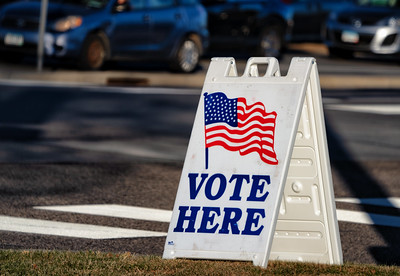
Voting is one of the most important rights of American citizens. This module will help students gain a better understanding of voting, campaigns, and elections in the United States. It will also provide a clear understanding about the strengths and weaknesses within our democratic system, and the importance of voting, civic engagement, and political participation.
Image Attribution: Tony Webster on Flickr Attribution 2.0 Generic (CC BY 2.0).
Upon completion of this module, you will be able to:
- Identify factors and circumstances that prevent citizens from voting. (CLO 5)
- Explain the difference between the Electoral College versus popular vote in the Presidential election in the United States of America. (CLO 5)
- Identify the factors that affect a voter's decision in an election. (CLO 5)
- Identify the stages in the U.S. election process. (CLO 5)
To achieve these objectives:- Read Chapter 7 in Introduction to American Government. Including:
- Introduction to Voting and Elections (opens in new window)
- Voter Registration (opens in new window)
- Voter Turnout (opens in new window)
- Elections (opens in new window)
- Campaigns and Voting (opens in new window)
- Direct Democracy (opens in new window)
- Chapter 7 Review (opens in new window)
Module Pressbooks Resources and Activities
You will find the following resources and activities in this module at the Pressbooks website. Click on the links below to access or complete each item.
- Identify factors and circumstances that prevent citizens from voting. (CLO 5)
-
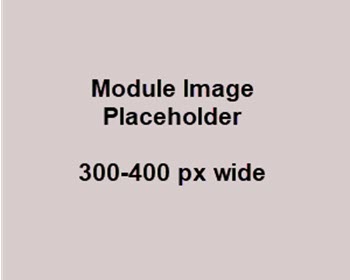
**Will create midterm over the summer**
In this module you will take your midterm exam/exam # [choose one] OR submit your midterm assessment for this course. Read the instructions carefully and take note of any special submission guidelines.
NOTE: Include this module for each exam or major assessment, edited as needed. Include attribution of your image (Title, Author, Source, License).
Upon completion of this module, you will have:
- Read and viewed the [midterm assessment name] instructions
- Scheduled your exam with the proctoring service [if applicable, delete if not needed]
- Prepared for and submitted your midterm assessment [revise as needed]
To achieve these objectives:
- Read and view the contents of "Exam Information and Instructions" [if applicable, delete if not needed]
- Review the [midterm assessment] guidelines in your syllabus to make sure you are ready. Click on [Title of Assessment below] and follow the instructions.
- Log in to the proctoring service and take your exam. [if applicable, delete if not needed]
-
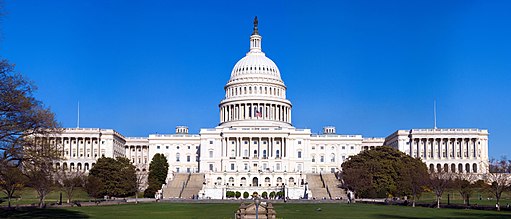
The Legislative Branch of government is the most important branch of the United States government. This module will explain Congress’s place in our constitutional system, the role of Congress, its structure, and party leaderships. Students will gain a clear understanding on the process of creating laws and the unique roles of the two houses within the federal government.
Image Attribution: The western front of the United States Capitol. Public domain.
Upon completion of this module, you will be able to:- Explain the election process in the United States. (CLO 5)
- Explain the functions of Congress. (CLO 1)
- Identify the steps in the legislative process in the U.S. (CLO 2)
- Define the term bureaucracy within the U.S. government. (CLO 2)
To achieve these objectives:- Read Chapter 11 in Introduction to American Government. Including:
- Introduction to Congress (opens in new window)
- The Institutional Design of Congress (opens in new window)
- Congressional Elections (opens in new window)
- Congressional Representation (opens in new window)
- House and Senate Organizations (opens in new window)
- The Legislative Process (opens in new window)
- Chapter 11 Review (opens in new window)
Module Pressbooks Resources and Activities
You will find the following resources and activities in this module at the Pressbooks website. Click on the links below to access or complete each item.
- Explain the election process in the United States. (CLO 5)
-
The presidency system of the United States is a national system. The President is head of the Executive Branch of government and has staffers and Cabinet members to help run the federal government. We will examine the historical position, structure, and presidential powers of the position.
Image Attribution: Public Domain. From White House website.
Upon completion of this module, you will be able to:- Distinguish the evolution of presidential power. (CLO 1)
- Describe the constitutional and statutory powers of the president today. (CLO 1)
- Explain how the Executive Office of the President, the vice-president, the first spouse, and the Cabinet help the president. (CLO 5)
- Explain how modern presidents have become even more powerful. (CLO 5)
To achieve these objectives:- Read Chapter 12 in Introduction to American Government. Including:
- Introduction to the Presidency (opens in new window)
- The Design and Evolution of the Presidency (opens in new window)
- The Presidential Election Process (opens in new window)
- Organizing to Govern (opens in new window)
- The Public Presidency (opens in new window)
- Presidential Governance: Direct Presidential Action (opens in new window)
- Chapter 12 Review (opens in new window)
Module Pressbooks Resources and Activities
You will find the following resources and activities in this module at the Pressbooks website. Click on the links below to access or complete each item.
- Distinguish the evolution of presidential power. (CLO 1)
-
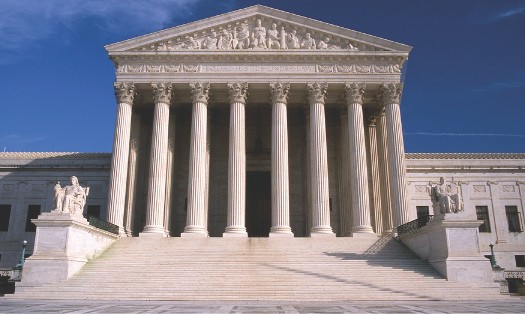
The judiciary system of the United States is the federal system under a national government that is a dual court system. It consists of a three-tier national court system as outlined in the U.S. Constitution and fifty state court systems based on the Constitutions of each of the fifty states. In this module, we examine the evolution, organization, structure, and processes of the courts at the national and state levels. As the ultimate appellate court and the least democratically elected branch of government, we especially focus on the U. S. Supreme Court in relation to both federal and state courts. The power and decision-making of the U. S. Supreme Court in protecting citizens and shaping and impacting policy is also discussed in this module.
Image Attribution: Public Domain from the Supreme Court of the United States website.
Upon completion of this module, you will be able to:- Discuss
the importance of the evolution and organization of the courts to
impacting and shaping the protection of citizen’s rights and freedoms. (CLO 1, 4)
- Explain the different kinds of cases and the ways they are handled at the federal and state levels of government. (CLO 1, 2, 4)
- Discuss the nature of judicial politics in defining the law and policy through judicial interpretations. (CLO 1, 3, 5)
- Describe the selection process of the members to the U.S. Supreme Court and the
nature of the Supreme Court’s decision-making process in rendering major
court decisions. (CLO 1, 2, 5)
To achieve these objectives:- Read Chapter 13 in Introduction to American Government. Including:
- Introduction to the Courts (opens in new window)
- Guardians of the Constitution and Individual Rights (opens in new window)
- The Dual Court System (opens in new window)
- The Federal Court System (opens in new window)
- The Supreme Court (opens in new window)
- Judicial Decision-Making and Implementation by the Supreme Court (opens in new window)
- Chapter 13 Review (opens in new window)
Module Pressbooks Resources and Activities
You will find the following resources and activities in this module at the Pressbooks website. Click on the links below to access or complete each item.
- Discuss
the importance of the evolution and organization of the courts to
impacting and shaping the protection of citizen’s rights and freedoms. (CLO 1, 4)
-
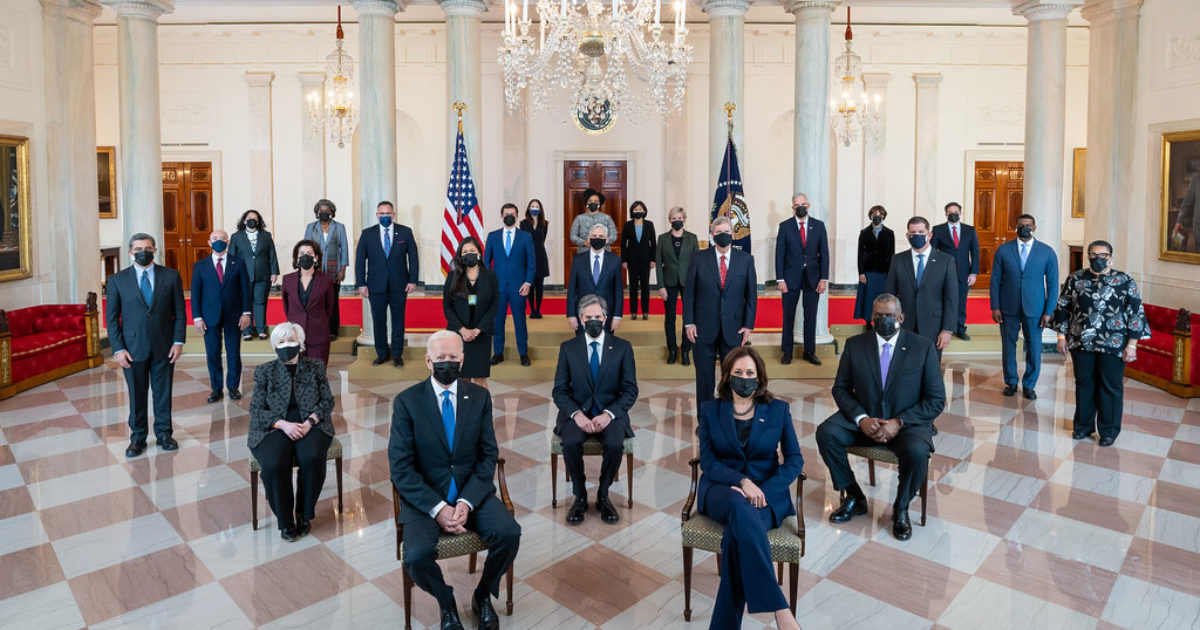
In this chapter, we will explore the role and functioning of the Federal Bureaucracy. Through the course of this module, you will be exposed to different theories about the bureaucracy, as well as how the bureaucracy interacts with other elements of the government. Additionally, you will see the role the bureaucracy plays not only in the government, but in how it interacts with the government in your daily life.
Image Attribution: “Cabinet of President Joe Biden in April 2021” by Adam Schultz, The White House/Wikimedia Commons, Public DomainUpon completion of this module, you will be able to:- Identify the elements of the Federal Bureaucracy. (CLO 2)
- Explain the difference between Professional and Political Bureaucracy. (CLO 2)
- Describe the process of turning legislation into regulation. (CLO 5)
To achieve these objectives:- Read Chapter 15 in Introduction to American Government. Including:
- Introduction to the Bureaucracy (opens in new window)
- Bureaucracy and the Evolution of Public Administration (opens in new window)
- Toward a Merit-Based Civil Service (opens in new window)
- Understanding Bureaucracies and Their Types (opens in new window)
- Controlling the Bureaucracy (opens in new window)
- Chapter 15 Review (opens in new window)
Module Pressbooks Resources and Activities
You will find the following resources and activities in this module at the Pressbooks website. Click on the links below to access or complete each item.
- Identify the elements of the Federal Bureaucracy. (CLO 2)
-
Ultimately speaking, domestic policy creation is one of the key goals of politics. If most of the discussion in this course has been focused on the gaining of influence and getting into office, these last two modules will focus on how that power and influence is used. The domestic economic and social policies that are crafted by the government directly impact the course of American life. By understanding how the policy process takes place, you will be better informed about how to influence the government to better reflect your desires.
Image Attribution: Lisa Ferdinando, Department of DefenseUpon completion of this module, you will be able to:- Explain the main points of contention within American Domestic Politics. (CLO 5)
- Describe the domestic policy process. (CLO 5)
- Identify problems in the domestic policy process. (CLO 5)
To achieve these objectives:- Read Chapter 16 in Introduction to American Government. Including:
- Introduction to Domestic Policy (opens in new window)
- What is Public Policy? (opens in new window)
- Categorizing Public Policy (opens in new window)
- Policy Arenas (opens in new window)
- Policy Makers (opens in new window)
- Budgeting and Tax Policy (opens in new window)
- Chapter 16 Review (opens in new window)
Module Pressbooks Resources and Activities
You will find the following resources and activities in this module at the Pressbooks website. Click on the links below to access or complete each item.
- Explain the main points of contention within American Domestic Politics. (CLO 5)
-

The United States is one of the most powerful and influential players in the international system. The decisions that are made within the foreign policy realm impact not only the United States, but states around the world. As the world's largest economic and military power, the United States' position as hegemon determines the rules of the international system. In this module, you will examine how the USA interfaces with the international system, as well as what the different schools of thought within international relations are. This module will help place the United States into an international context of many different actors within the international system.
Image Attribution: Public Domain. U.S. Embassy in New Zealand Flickr account.Upon completion of this module, you will be able to:- Differentiate between Realism and Liberalism. (CLO 5)
- Explain the elements of the Foreign Policy Apparatus. (CLO 5)
- Explain how the foreign policy process works. (CLO 5)
To achieve these objectives:- Read Chapter 17 in Introduction to American Government. Including:
- Introduction to Foreign Policy (opens in new window)
- Defining Foreign Policy (opens in new window)
- Foreign Policy Instruments (opens in new window)
- Institutional Relations in Foreign Policy (opens in new window)
- Approaches to Foreign Policy (opens in new window)
- Chapter 17 Review (opens in new window)
Module Pressbooks Resources and Activities
You will find the following resources and activities in this module at the Pressbooks website. Click on the links below to access or complete each item.
- Differentiate between Realism and Liberalism. (CLO 5)
-

In this module you will take your final exam/submit your final assessment [choose one] for this course. Read the instructions carefully and take note of any special submission guidelines. Include attribution of your image (Title, Author, Source, License).
Upon completion of this module, you will have:
- Read and viewed the final assessment instructions
- Scheduled your exam with the proctoring service [if applicable]
- Prepared and submitted your final assessment
To achieve these objectives:
- Read and view the contents of the module book "Exam Information and Instructions" [if exam only]
- Review the final assessment guidelines in your syllabus to make
sure you are ready. Click on [Title of Assessment below] and follow the instructions.
- Log in to the proctoring service and take your exam. [if exam only]
